TechRadar Verdict
The LG OLED88Z9 is LG’s first 8K OLED TV, sporting its biggest screen to date and ensuring a suitably dramatic experience with HDR. It’s superbly specified with a comprehensive smart platform, extensive features and a big soundstage. Just don’t ask about the price…
Pros
- +
Astonishing picture quality
- +
Remarkable blacks and contrast
- +
Dolby Vision and Atmos
- +
AI-enhanced smart platform
- +
Big soundstage
- +
Gorgeous design
Cons
- -
Lacks HDR10+ support
- -
Limited HDR brightness
- -
Can’t be wall mounted
- -
Outrageously expensive
Why you can trust TechRadar
LG’s late arrival into the 8K TV market has provided arch-rival Samsung with a chance to establish a firm foothold, launching two ranges - the Samsung Q950R and Samsung Q900R - and a number of different screen sizes.
However LG hasn’t been idle this entire time, toiling away in secret on a dream TV of their own. To that end, the Z9 is a clear statement of technological intent that doesn’t just support an 8K resolution but also sports the biggest OLED panel to date.
As you'd expect, the Z9 comes fully loaded all the features found on LG’s other 2019 OLED TVs including state-of-the-art processing, HDMI 2.1 connections, Dolby Atmos and the awesome webOS smart platform with a full house of AI assistants. The Z9 also includes an 8K upgrader box designed to keep this TV cutting edge for years to come - preserving your investment.
- Check out the whole LG TV 2019 range
Price and release date
So how much does it cost? The Z9 comes in a single screen size of 88 inches (OLED88Z9PLA) and is currently available for £29,999 / $29,999.
Design
Screen Size: 88-inches | Tuner: Freeview HD, satellite HD | 8K: Yes | HDR: Yes | Panel technology: OLED | Smart TV: Yes, webOS and ThinQ AI | Curved: No | Dimensions: 1961(w) x 1456(h) x 281(d)mm | Weight: 102kg | 3D: No | Inputs: 4xHDMI 2.1, 3xUSB, 2xRF, optical, analogue, headphones, CI slot
The LG Z9 certainly looks like a premium product with a gorgeous design that somehow manages to appear discreet and tasteful despite its 88-inch screen size. The bezel-less design and ultra-thin OLED panel certainly help, but it’s the stand that provides a sense of airiness and space.
This stand is finished in silver brushed metal and permanently attached to the panel, which means there’s no wall mount option. The hole in the middle isn’t just a design choice, it serves a practical purpose: the sound from the TV’s downward-firing speakers is redirected through the hole and towards the listener. There are also two subwoofers built into the bottom to boost the bass.
It’s an attractive design and the stand doesn’t just help make the TV sound better, it also sells the idea of a high-end product. The only slight problem with the stand is the brushed silver top is quite reflective, which might prove annoying with dark scenes at night. However a strip of dark material can fix that if you’re an image quality obsessive (and at this price you probably are).
As with the rest of LG’s OLEDs this year, the Z9 has a full complement of HDMI 2.1 inputs. This latest version of HDMI is essential for 8K and can handle a staggering 48Gbps. It also supports higher frame rates up to 120Hz, dynamic metadata for HDR, eARC (enhanced audio return channel), variable refresh rates (VRR), and an auto low latency mode (ALLM).
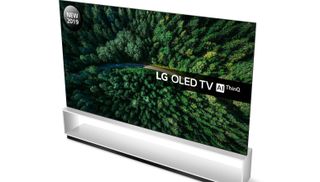
In total there are four HDMI inputs: three at the side and one facing the rear. There are also three USB ports, with one at the side and two facing rearwards, along with a terrestrial and satellite tuner, a LAN port, a CI slot, an optical digital output, and a line out that doubles as a headphone jack. On the wireless side of things, there’s built-in WiFi (802.11ac), Bluetooth (5.0) and AirPlay 2.
There are currently a number of 8K compression codecs in development, so to avoid the Z9 suddenly finding itself superfluous LG is releasing an upgrader box at the end of the year. This will be free to existing owners, and bundled with new purchases from the beginning of 2020. The box connects to the Z9 using an HDMI input and USB port, and can be updated as and when new 8K compression codecs becomes available, ensuring your expensive TV remains cutting-edge.
The Z9 uses LG’s Magic Remote but for this new flagship TV the controller has been given a makeover, with a gorgeous high-end silver metal finish that matches the stand. The button layout is essentially the same, although there have been a few minor changes, but the on-screen pointer remains a joy to use and makes interacting with the TV responsive, precise, and intuitive.
Design TL;DR: Despite its size this TV looks attractive and discrete thanks to a minimalist design. HDMI 2.1 connections and an upgrader box ensure it will also remain future proof.
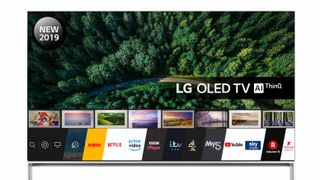
Smart TV (webOS with ThinQ AI)
The LG Z9 uses the webOS smart platform, which remains as revolutionary now as it did when released. It’s built around a launcher bar, with a second tier designed to make accessing content quicker. There’s an AI Preview that makes recommendations based on your viewing habits, and an Intelligent Edit feature that lists your apps based on how often you use them.
Intelligent Edit is a particularly handy feature because LG’s TVs boast a comprehensive selection of apps and streaming services, including Netflix, Amazon, YouTube, Now TV, Rakuten, and all the UK TV catch-up services. Even better, all these streamers support HLG, Dolby Vision and Dolby Atmos where appropriate, including via AirPlay 2.
There’s a Home Dashboard that collates all connected devices into a single hub. You can monitor and control just about any part of your smart home, and for Apple fans there’s also support for HomeKit. LG’s ThinQ open AI platform has Google Assistant and Amazon Alexa built-in, which you can access by pressing the mic button on the remote. As a result the Z9 isn’t just a TV but a smart assistant that’s able to answer questions and provide voice control.
Smart TV TL;DR: webOS remains the best and most comprehensive operating system available, but the inclusion of AI-enhancements, Apple, Amazon and Google also makes it the smartest.
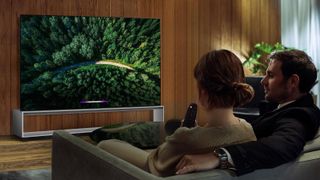
HD/SDR Performance
The LG Z9 uses an 88-inch 8K (7680 x 4320) 10-bit OLED panel, which equates to over 33 million self-emissive pixels. This is one of the reasons the screen is so big, LG are struggling to fit all those pixels into a smaller OLED panel.
To accommodate this increased resolution the Z9 uses an updated version of LG’s 2nd generation Alpha9 intelligent processor, which employs deep learning algorithms to analyse content before optimising the image using upscaling and processing such as six-step noise reduction, frequency based sharpness enhancements, object depth enhancements, and colour enhancements.
A big screen is great if you want an immersive experience, but it also tends to mercilessly reveal any limitations in the source material. Thankfully the Z9 has you covered with its AI-enhanced processing, using machine learning to perfectly upscale heavily compressed and lower resolution content. This feature works wonders with standard definition TV and DVD, along with some streaming content – just don’t expect miracles.
When it comes to Full HD content such as Blu-rays, the higher quality source doesn’t require as much processing, so with the AI Picture mode switched off the results still look spectacular. The greyscale accuracy is fantastic, with the Blu-ray of High Noon basking in a gorgeous black and white image with deep blacks, clear whites, excellent shadow detail and lovely shades of grey.
Moving on to something a little more recent, the Blu-ray of Gravity reveals a pristine image that’s bursting with detail. The upscaling is superb, the contrast of the white suits and ships really pops against the blackness of space, and the motion is fluid. The Z9’s colour accuracy is equally impressive, with the gorgeous photography in Samsara looking perfectly saturated and realistic.
HD/SDR Performance TL;DR: The optimised Alpha9 processor makes full use of all the pixels in the 8K panel, while the AI Picture mode gets the best out of compressed or low res material.
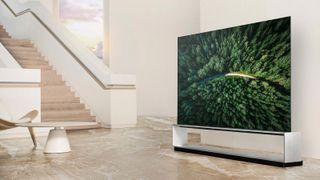
4K/HDR Performance
When it comes to 4K HDR content the Z9 is an absolutely stellar performer, producing some of the best images we’ve seen. In part this due to a solid basic performance, with a peak brightness of nearly 800nits and the ability to cover almost 100% of the DCI-P3 colour space. The tone mapping is also superb, tracking the target PQ curve target precisely.
As a result watching a first class 4K disc like Blade Runner 2049 reveals exceptional levels of detail, and colours that are both saturated and nuanced. The scenes in Las Vegas are bathed in an orange mist, but there isn’t a hint of banding thanks to the 10-bit video depth. The tone mapping is also spot-on, with deep blacks, plenty of shadow details and highlights free of clipping.
Another great example is Alien, which uses a new 4K restoration of film’s original camera negative. The result is a beautiful image that remains film-like thanks to the Z9 not removing the grain, but which also retains incredible levels of detail within the frame. The blacks appear infinite, while unseen dangers lurk in the shadows as the camera prowls the Nostromo’s corridors.
The Z9’s dynamic tone mapping does a great job of bringing out all the details in dark scenes, while ensuring other parts of the image appear brighter. The infamous chestburster scene is a great example, with realistically dark blood glistening off the baby alien, and red jets spraying the pristine white walls of the mess room. The effect is as mesmerising as it is visceral.
Alien is encoded using HDR10+, but unfortunately the Z9 doesn’t support that format so it only displays the base HDR10 layer. However it does support Dolby Vision, which the other format to employ dynamic metadata, and Aquaman boasts stunning HDR thanks to the addition of Dolby Vision on its UHD Blu-ray release.
The underwater sequences are nothing short of breathtaking, with Aquaman’s descent into ‘The Trench’ while being lit only by a flare a particular highpoint. The bottomless depths are impossibly dark, but the brightly lit Saharan sequences really shine, and the Sicilian village pushes the colour gamut to the max, creating remarkable HDR images.
The Z9 is also an accomplished display for gaming, and a non-HDR title like Forza 6 delivers detailed images and smooth motion that draws you into the frenetic racing action. Alternatively an HDR-enhanced game like Star Wars: Battlefront II gives the lightsabers and blasters greater impact. Not only is the motion smooth but the gameplay is highly responsive, with an input lag of 17.9ms – a measurement that’s sure to please hard-core gamers.
4K/HDR Performance TL;DR: Although not as bright as QLED, this 8K TV delivers incredible HDR images with remarkable levels of detail. Only the lack of HDR10+ support disappoints.
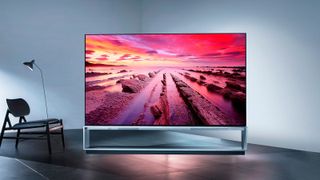
8K/HDR Performance
As amazing as 4K HDR and Full HD SDR content looks on the Z9, the elephant in the room is the general lack of native 8K content outside of Asia. It’s a shame, because if you can actually get hold of some native 8K content the results are absolutely spectacular on this TV.
LG provided a short Spears and Munsil demo reel with 8K HDR10 footage that is simply stunning in terms of the fine detail on display. Every tree, leaf, or blade of grass is perfectly defined, and since the Z9 is an OLED the blacks are suitably inky, while the shadows retain detail. Highlights are free of clipping, colours beautifully saturated and the overall effect is like looking out of a window.
LG has recently raised the question of what exactly constitutes 8K resolution? The answer seems obvious: count the number of pixels. While that isn’t as easy as it sounds, the generally accepted approach uses contrast modulation (CM), which not only determines the actual number of pixels but also establishes how well they can be distinguished.
Using this method of evaluation LG's 8K TVs perform very well, with each pixel clearly defined. However when viewing the pixels on some competing 8K TVs up close, they appear blurry. The reason for this is that the technology employed on some VA LCD panels to improve the viewing angles also affects the pixel definition.
While this issue is obvious under a microscope or looking at test patterns from a few centimetres away, it’s impossible to see from a sensible viewing distance (even on a very large screen). All that really matters is the quality of the perceived 8K image, and regardless of the method used to measure resolution the Z9 is objectively and subjectively an awesome display.
8K/HDR Performance TL;DR: The benefits of 8K are subtle but there’s no denying the images look breathtaking. It’s just a shame there’s so little native 8K material available.

Sound
The LG Z9 sounds fantastic thanks to a 4.2-channel audio system that takes full advantage of the larger screen size and built-in stand. There’s more room at the bottom of the panel for four fairly big downward-firing speakers, and a very effective channel that fires the sound directly at the listener. You’ll also find a pair of subs in the base of the stand, giving the low end added kick.
Along with the beefed-up sound the Z9 also includes a full raft of all LG’s sonic features, such as One Touch Sound Tuning that uses the mic in the remote to analyse the room from your main listening position and set-up the audio accordingly. In addition, the AI Sound mode applies machine learning and psychoacoustic wizardry to up-mix 2.1 to virtual 5.1 surround sound.
The Z9 also supports Dolby Atmos, and the jazz-influenced soundtrack of La La Land sounded fantastic, from the uptempo ‘Another Day of Sun’ to the more sombre ‘City of Stars’. However thanks to 80W of built in amplification you can also crank the volume, ensuring Freddie Mercury’s operatic voice fills Wembley Stadium during the climatic Live Aid set in Bohemian Rhapsody.
Sound TL;DR: The bigger screen size and built-in stand allows LG to fit in a 4.2-channel audio system with larger speakers, two subs and 80W of amplification. As a result it sounds superb.
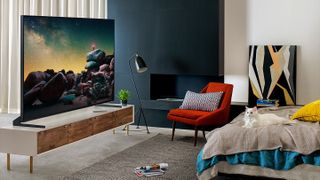
Other panels to ponder...
If you like the idea of an 8K TV, the obvious alternative is the Samsung Q950R. This QLED model is available in a range of screen sizes and despite LG’s claims about measured resolution, it delivers gorgeous 8K images and standard-setting HDR. There’s AI-enhanced processing and sound, along with an effective and comprehensive smart platform that includes Apple TV. There’s also support for Dolby Atmos and HDR10+, with Dolby Vision about the only major feature missing. Overall the Q950R represents one of the most cost effective ways of getting into 8K.
Although if you want bang for buck and you like the idea of a big screen OLED TV, you should really be considering LG’s 77-inch C9 OLED (OLED77C9). This 4K HDR TV might not support 8K, but it sports just about every other feature found on the Z9. That means you get the 2nd gen Alpha9 processor, HDMI 2.1, Dolby Vision, Dolby Atmos, AI Sound, webOS and all the smart assistants. It’s also a cracking performer, capable of superb SDR and HDR images. If you want big screen OLED action, the C9 is currently your best and cheapest bet.
Final verdict
The LG Z9 represents the apex of OLED design with an 88-inch 8K panel and a comprehensive set of specifications and features. The performance is incredible, even if there is currently a lack of native 8K content, but thanks to the inclusion of HDMI 2.1 connections and an 8K upgrader box this flagship TV should remain up-to-date for years to come.
The design is eye-catching without dominating the room, and the beefed-up sound is excellent. LG has applied AI machine learning to the image processing, sound, and weOS smart platform, with the latter remaining the system by which all others are measured. The Z9 is a premium TV that delivers a premium performance, but it comes with a premium price.
- Looking for something more... attainable? Check out our list of the best 4K TVs
- Get the best deal on LG products with our LG coupon codes.
Stephen is a freelance reviewer with over ten years experience writing for all the major tech publications. As a lifelong film fan he’s embraced the evolution of home entertainment over the decades, and as a professional audio and video calibrator he’s able to keep abreast of the latest developments and innovations. When not reviewing the latest products, Stephen can be found obsessing over how to cram a bigger screen and more speakers into his own home cinema.

